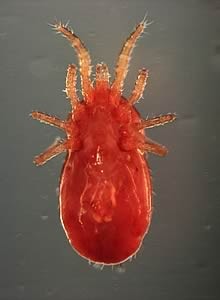Red mites, Dermanyssus gallinae, are blood feeding parasites that have considerable welfare and production implications for poultry, most commonly commercial laying hens. Dawn Prime spoke to Alison Colville-Hyde, from St David’s Poultry Team to answer some key questions.
How do I know if my poultry have got red mite?
Red mites can survive for a long period of time without feeding from poultry, and this is why an effective clean out of any buildings and between cycles of poultry is essential.
The red mite is a nocturnal parasite and only comes out at night to feed, during the day the 1mm long red mite hides away in any little gaps in the poultry unit. A test to see if you have red mite is to press white paper on to the suspected red mite, if it is red mite then red streaks will appear, these red streaks are blood. It is also possible to see mites that have not yet fed, these are grey in colour.
What is the lifecycle of the red mite?
It is really important to understand how the red mite reproduces in order to apply good preventative measures. The length of the complete lifecycle can vary and is dependent on the environmental temperatures. Adult red mites lay eggs which then develop into larvae. After the larvae stage, it is followed by two nymph stages before the mite begins its adult life to lay eggs. Before the red mite begins to breed, they must have a blood meal. When the temperature rises in the shed, the female mite can lay more eggs and the lifecycle is completed quicker.
What signs should I look out for?
Red mites can cause various symptoms in poultry including anaemia, weakness, dullness, restlessness and skin irritation. It is also possible for the keepers to get itchy but the mite cannot live on humans. If you are suffering from extreme cases of red mite then mortality is possible in the flock.
Red mites are a vector of disease including salmonella, mycoplasma, coccidiosis and e coli. Apart from the diseases they can transmit, the consequences of a large infestation can be greater because of the issues that cause to the flock due to stress.
The parasite can be responsible for production issues such as sudden decrease in egg production or an increase in mortality. Red mites cause a great deal of stress to birds and eggs can be downgraded due to spots and smears. Having a red mite infestation can affect bird behaviour and causes them to reduce preening and increases feather loss. This then has a knock-on cost because feed consumption will increase as the birds fight to maintain body warmth.
What are the treatment and preventative measures for red mite?
Eradicating red mite can be difficult as the mite is very resistant. Hygiene is the most important factor in prevention but no matter how effective the clean out is, reinfection is highly likely.
Red mites are very resilient to certain groups of chemicals. Before using specific products it is vital to contact your veterinary surgeon who will advise you on the best products to use. Your vet will want to know:
- Style of poultry unit
- Age of poultry
- Size of flock
- System you use to feed and water chickens
Once the product has been chosen, it is important to bear in mind any egg or meat withdrawal.
If red mite has been diagnosed in a commercial unit then cleaning the unit as soon as possible with a strong detergent is vital. Once the birds have gone, there will be a dip in temperature and mites can detect this and so will move themselves deeper into gaps in the wall. After the initial clean another clean should be given and then a final clean before any new birds are introduced.
It is vital to monitor red mite populations on a weekly basis, especially after restocking. The results of these checks should be written down and become part of the long-term flock management plans. If you find that your poultry are suffering severely with red mite, then further treatment should be carried out. If you have any concerns, always seek veterinary advice.


